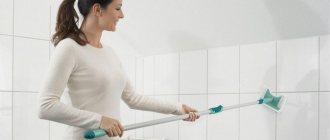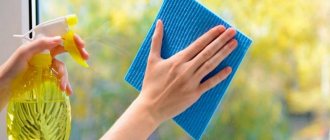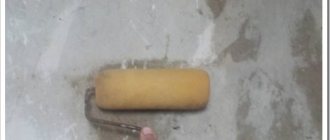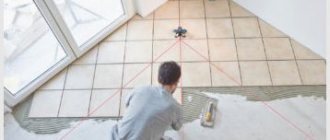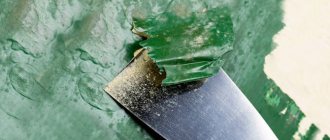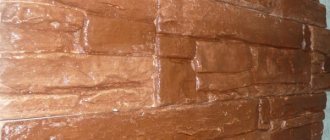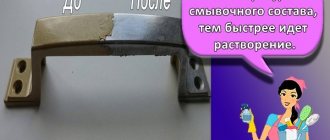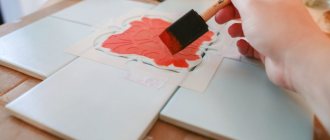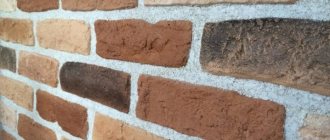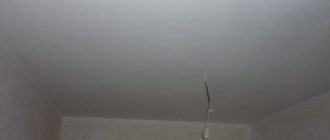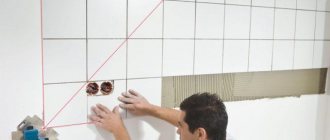During repair work, careless handling of tools and materials leaves a lot of contamination from construction mixtures, paints, sealants, and glue. If you don’t protect your floors, you’ll probably have to decide how to remove the primer from the tiles and the paint from the wallpaper. This can ruin all the joy from the updated interior. To protect yourself from unnecessary expenses, you need to take a responsible approach to the choice of covering materials and devices for open surfaces. It is enough to protect the floor and walls in time with thick paper, cardboard or plastic film, so that later you don’t have to guess how to wash the dried primer from the tiles. Old boxes from household appliances, bags from bulk products and putty will do for this. It is important to pay special attention to cleanliness when painting with primers, since their task is to prepare the surface for applying finishing paint or wallpaper glue, increase their adhesion, and increase the hardness of the top layer of the wall.
How to properly remove paint from a tiled floor?
The easiest way to clean tiled floors. The glaze, which makes up the protective film of the tile, is not susceptible to the penetrating properties of acrylic primers and is easily washed off with plain water and a dish sponge. It is more difficult with alkyd and polyester paints. They contain organic solvents that damage the glaze and spoil its appearance. It's even more difficult with ceramic tiles. It has pores that are easily filled with paint and are very difficult to part with. In this case, you can no longer do without cleaning products.
How to remove primer from ceramic tile floor tiles? First of all, you need to find out about this from the information on the paint packaging. The manufacturer will tell you how to remove the primer from the tiles. You need to start cleaning the floor immediately, as dried paint is much more difficult to remove. It is better to use cotton rags, which absorb any liquid very well, regardless of their chemical composition. An ordinary batting cloth, sold in hardware stores, is suitable for this.
What is the best way to wash?
To clean the tiles on the floor, you can choose a cleaning product from among those that are sold in household chemicals departments. Among them there are universal remedies, and analogues aimed against certain types of pollution. Among the positively proven products, Silit is usually chosen, which effectively removes dirt from ceramic surfaces.
“Selena” has a low price and cleans the floor without streaks. "Mr. Proper" is classified as a universal floor cleaner. It is effective in cleaning porcelain tiles. A more expensive drug is Amway. It has proven itself in the fight against dirt and stains.
Please note that it is not recommended to use products in the form of powder for ceramics; they can damage its surface.
If you don’t want to buy special chemicals, or they’ve run out, you can use home remedies:
- Ammonia. It is diluted in water in the proportion of 1 tablespoon per 1 liter of liquid. The mixture is applied to the surface of the tile using a spray bottle. Then the tiled floor is washed and wiped.
- Vinegar. It must be diluted in water at the rate of 3 tablespoons per 1 liter. Use in the same way as with ammonia.
- Citric acid or lemon juice. This product is applied to a sponge and, without unnecessary pressure, the dirty areas of the tile are wiped.
- Chalk. You need to rub the paper with chalk, and then use the paper to clean the glossy tiles.
- Washing powder. It is used in the form of a solution, mixed with warm water. Moisten the dirty tiles with the product and leave to soak for about 10-15 minutes. After this, the solution is washed off.
- Kerosene. It is good to use immediately after repair. It effectively removes traces of construction mixtures and rust. Using a rag soaked in kerosene, you need to treat the contaminated areas of the tile, and then the floor needs to be washed.
After using any product, the tiles must be wiped dry using a paper towel.
How to remove dried primer from tiles?
When hardened primer remains unremoved for an extended period of time, it is next to impossible to remove. Even if the paint has dried, it is necessary to get rid of it as soon as possible. First, try to remove the paint film using a scraper or spatula. The primer that has retained its elasticity will pull the entire mass with it. If it gives in, then very carefully, not allowing the total mass of paint to separate, remove the contamination. If the coating has become brittle, then chip off pieces of it without effort, trying not to damage the base.
After this, they decide how to clean the primer from the tiles. Once again, the most ordinary dish sponge turns out to be an indispensable tool. When choosing it, it is better to give preference to light-colored or colorless sponges, since low-quality specimens, under the influence of cleaning agents and friction, release the paint that is in their composition. Such a sponge will do more harm than good.
Steam generator
Another option is to use a steam generator. It is unacceptable to use a steam generator to clean primer from glass. It is applicable exclusively for tiles. When exposed to high temperatures, the glass will simply burst.
Important! If the tile is glazed, then it is unacceptable to use a steam generator. Such a surface will crack and become unusable.
Taking this into account, it is better to use a steam generator for floor coverings, which are much stronger and of higher quality.
The stain removal process is very simple:
- Turn on the steam generator and make sure there is water in the container.
- Direct a stream of hot steam at the contamination.
- Gradually the stain gets wet.
- After this, it should be removed using a stiff brush.
Features of removing paint from wall tiles
When solving the problem of how to wash the primer from the tiles on the wall, you need to choose thick cleaning products, since dealing with drips can become a headache. Solvents reduce the viscosity of paints, and the resulting solution penetrates even more deeply into porous surfaces and tile joints. When working, it is necessary to hold the highly absorbent material slightly below the cleaning area. This technique will prevent the dissolved paint from flowing along the wall. To speed up the process when cleaning walls, you can use more active products, since working on vertical surfaces is more difficult.
Peculiarities
The beauty of tile is that it is a durable surface. It is durable, withstands mechanical stress well without damaging the surface structure. This material is convenient to use in bathhouses, bathrooms, kitchens and other rooms where humidity is high. With careful attention, the tile will retain its aesthetic and protective qualities well.
Removing primer stains from tiles and stone
Bright, contrasting stains from tinted primer are the most difficult types of stains. How to remove primer stains from tiles? In this case, you need to carry out a whole cycle of work. If the oil-based primer has had time to dry, then the first step is to clean it mechanically. Oil paints are elastic and difficult to remove from surfaces.
In addition, they have good adhesion to surfaces. Oil-based primer films are not resistant to heat, so it is better to warm up the area of contamination. Then, using purified kerosene or a solvent for oil paints, the stains are removed.
Removing cement mortar
In addition to grouting compounds, other building mixtures used during repair work can also come into contact with tiles. Stains noticed immediately are not difficult to remove. It is enough to wipe them with a rag and rinse the residue with water.
Problems begin after the material dries. An ordinary solution acquires its final strength only after several days. Therefore, the main thing when removing it will be softening: you need to sprinkle the stain with soda powder and cover with wet rags. Be sure to use only cold water, as hot water enhances the adhesion of the solution. Then scrape off what you can with spatulas and sharp blades.
To completely remove cement, it is permissible to use the same chemicals as for the primer. But in this case, you should not resort to strong compounds, since cement mixtures are easier to remove.
How to remove acrylic primer from tiles?
The easiest way to get rid of acrylic compounds. This is a water-soluble paint that can be easily removed with ordinary household dishwashing detergents or simple washing powder. These contaminants can be easily cleaned mechanically. Dried acrylic primer is brittle and inelastic. With the help of a scraper, it can be easily removed from both the walls and the floor. However, even this primer adheres firmly to ceramic floor tiles.
It is even more difficult if it is a deep penetration primer. The chemical reaction in it makes it resistant to almost all cleaning methods. It is necessary not to allow such a primer to dry. To do this, until the stain is completely washed off, you need to ensure constant humidity of the surface, pour boiling water over it and leave a damp cloth on it. But the most effective way to combat acrylic stains is steam.
What types of pollution are there?
There are a wide variety of stains on floor tiles. It can be:
- Stains from poorly washed off or ingrained dirt left after repairs. Traces of grout, primer, glue, and construction dust remain when they are hastily washed off. If all this has already dried, it will take a lot of effort to bring the tiles to a sparkling clean.
- Black stripes on light tiles. These may be traces of cutting tiles left after repairs. If marks on the surface of the tile appear later, this indicates the presence of mold.
- Dirty water. If during the cleaning process the water itself becomes cloudy due to dirt that has entered it, the cleaning will have to be repeated. For prevention, it is better to change the water more often.
- Hard water. White marks appear on the tiles from hard water, indicating the content of various salts in it. Such marks can often be seen on the bathroom floor where moisture accumulates.
- Detergent. Poorly rinsed floor cleaners can leave marks on the tiles (especially if they are glossy).
- Dirty sponge or rag. Stains on tiles can occur if you use a poorly washed rag or sponge for cleaning. The only remedy for this is to monitor the condition of your cleaning rags.
- Food contamination. On the tiles in the kitchen you can periodically see traces of sugar, fat and other products. Cleaning using folk remedies and household chemicals will help here.
List of products for quick stain removal
What do you need to quickly clean paint stains to prevent them from setting? It is important to quickly respond to their appearance. To do this you need to have the following list of funds:
- several types of absorbent materials, preferably of natural origin;
- scrapers made of strong plastic with a metal handle;
- metal scrapers with a strong handle;
- a set of organic solvents for different paints;
- a set of household cleaning products;
- several packs of baking soda;
- small container with concentrated acetic acid.
Removal of different types of soils
How you wash off the primer will depend on the type of primer you use.
| Type of soil | Cleaning method |
| This is an adhesive based primer. The walls are impregnated with it to ensure a better adhesion of the wallpaper to the surface. Often such a primer has to be wiped off the floor, glass, and window sills. When fresh, immediately after contamination, the primer is removed with plain water. When dried, it can be removed with an alcohol-based glass cleaner. |
| Use before covering the surface with water-dispersed paints. With their help, walls are leveled. Then the paint looks more beautiful and adheres better. In most cases, acrylic primer can be washed with boiling water, but you need to be careful with it if the surface cannot be exposed to hot water. If the primer is very ingrained, it must be removed with a solvent. |
| Designed for reliable adhesion of the base to the finishing material. After complete drying, it can only be removed mechanically. The primer can be removed from windows, plastic or ceramics with a penknife or blade; special scrapers have also been invented for these purposes. Using tools, pry up the edge of the stain and remove it completely or in pieces. If the surface does not require mechanical impact, the primer can be wiped off using an organic solvent. The essential oils included in its composition cause the primer to swell. A rag soaked in solvent should be placed on the stain, left there for at least an hour, then carefully remove the remaining soil with a damp sponge. |
| The wood is impregnated with it before final installation. If the primer gets on tiles or linoleum, it can be removed with a damp cloth. If the soil has dried on the ceramics, wash it with an organic solvent and a hard sponge. The stain must be moistened with solvent, and after 5 minutes. wipe with a sponge. The procedure is repeated until the soil is completely removed from the surface. |
| Penetrating primer is quite difficult to wash off, so before applying it you need to protect surfaces not intended for treatment as much as possible with masking tape, cellophane and protective films. You can wash off an already dried stain by applying fresh primer on top of the dry one. This option is suitable for wood base. To wipe the mixture off the linoleum, you must first cover it with damp rags and then clean the dirt with a blade. |
Sequence of actions when cleaning floor coverings
If the floor has had time to dry and the paint has penetrated deep into the coating, then it is important to choose the right way to wash the primer from the tiles first. You need to act in the following sequence:
- Using a cotton rag, you need to blot the stain and not allow it to harden;
- if after the first action a stain remains, then it is necessary to pour a suitable solvent on it and repeat this until it completely disappears;
- if the stain was not noticed in time and has hardened, then it is removed with a suitable scraper, being careful not to scratch the surface;
- soak the stain with a suitable solvent or boiling water;
- leave a cotton cloth soaked in solvent on the stain for several hours;
- Using a kitchen sponge, wipe away any remaining dirt, being careful not to increase its area.
Care Tips
In order for the porcelain stoneware floor or walls to remain in excellent condition for as long as possible, certain care rules must be followed:
- periodically treat the surface with wax-based compounds;
- annually use a special product designed to protect porcelain stoneware;
- to add shine, wash with lemon juice or vinegar solution;
- You can polish the glossy surface with a piece of felt cloth;
- unpolished porcelain tiles with a rough surface are cleaned using a steam generator, followed by treatment with a dry rag. It is better to clean immediately after contamination occurs.
- To ensure that there are no streaks left after washing porcelain tiles, it is enough to use glass cleaning products that contain alcohol.
To summarize, it can be noted that any contamination of porcelain stoneware is best removed without delay. But if you don’t have time, specialized products that can clean the surface of stains of any complexity will help.
Extreme cleaning methods
If nothing helps and there are no other means left, then stronger solvents are used, such as:
- chlorine-containing substances;
- solvents containing ammonia;
- vinegar essence;
- concentrated acid solutions.
When using these tools, you first need to worry about personal safety. All these liquids pose considerable danger. When working with them, you must use gloves, a respirator, and work only in a well-ventilated area.
Concentrated chlorine bleach for bedding is good for removing oil stains and other organic residues. Ammonia solvents will also remove oil paints. They can be used after bleach if its effect was not enough. When working with ammonia, be sure to use respiratory protection, as you can very easily get burned.
Vinegar essence will help remove stubborn stains on ceramic tiles and tiles. It penetrates deeply and does not harm the tile material. After this treatment, you need to thoroughly wash all surfaces with a baking soda solution. Such a complex treatment is very effective, since soda, when combined with acetic acid, causes the release of gas, which can push particles of unbound pigment out of the pores.
The most extreme method is to treat contaminants using solutions of hydrochloric and sulfuric acid. Hydrochloric acid degreases surfaces well and releases pigments bound by fatty films. Sulfuric acid dissolves organic dyes and metal compounds. All extreme methods are best left to professionals.
Vinegar essence
Vinegar essence for cleaning primers falls into the category of traditional methods. When working with vinegar essence, you must be careful. Vinegar vapors are dangerous to the human respiratory system.
It is recommended to protect the skin from getting the essence on the skin. Plus, the room should be well ventilated. All work can take place within ten minutes.
Pour vinegar essence onto the stain and wait about 15 minutes. After this time, wash everything off with a sponge. But remember that all work must be carried out wearing a protective mask.
Important! This method of cleaning primer from tiles is only suitable for acid-resistant types of tiles.
